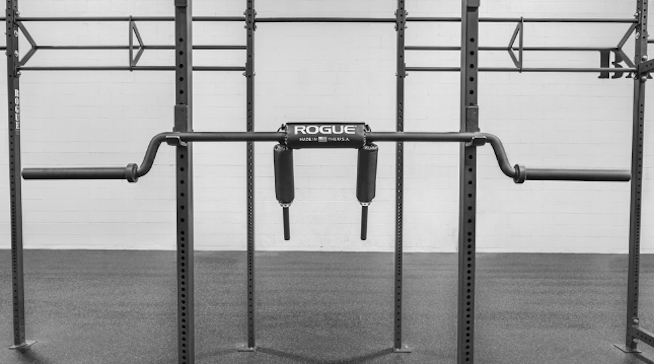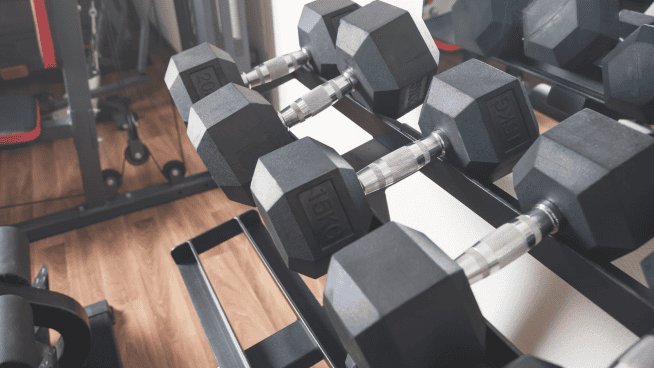Why You Should Squat With a Safety Bar Even If You Aren’t Injured
Over the past decade, we’ve witnessed a noticeable paradigm shift in the strength and conditioning industry.
Whereas heavy Back Squats once reigned as the king of all lower-body exercises, many practitioners now hesitate to program them, often citing potential lower-back issues as the reason for doing so. Some coaches even go so far to remove all heavy bilateral Squats from their athletes’ strength workouts, opting for Single-Leg Squat variations instead.
I’ve always found that approach to be overkill. There’s value in both squatting on one and two legs, so why not do both instead of picking one over the other?
But if standard Back Squats do hurt your lower back, how can you squat safely on two legs?
The safety squat bar may just be the answer. While this piece of equipment has historically been mostly reserved for those rehabbing upper-body injuries (particularly those of the shoulder), it’s much more than just a rehab tool. Even NFL Combine athletes have began using it to build serious strength.
In case you’re not familiar with it, the safety squat bar (SSB) features two handles that extend forward from the barbell, surrounded by three pads, in addition to a slight forward-cambered end on each side. It looks like this (photo via Rogue):

Squatting with the safety bar brings about two big benefits.
First, individuals with restricted shoulder mobility don’t have to “force” themselves under the bar and place unnecessary stress on the shoulder. The positioning required to squat with a normal barbell often leads to pain for these individuals. The safety bar allows you to hold the barbell via forward handles, so limited shoulder mobility won’t be an issue. Second, you can maintain a more upright position with a safety bar, which places less stress on your lower back.
This is great news for those who experience lower-back pain on regular Barbell Squats. Despite these clear benefits, some athletes worry that they won’t gain as much strength with the safety bar compared to a standard barbell, and even if they did, those gains won’t transfer to speed and power.
But is that really the case? Is squatting with a safety bar inferior to using a “real” barbell? A recent study provides some answers.
The Safety Bar Squat Study
The study, published in the International Journal of Sports Science, compared the Back Squat and Safety Bar Squat on measures of strength, speed and power in NCAA D1 baseball players over a 9-week training period.
A total of 28 baseball players participated in the study. Half of them (14 players) were pitchers, and the other 14 were non-pitchers. The pitchers squatted with a SSB to minimize stress on the shoulders and elbows. The non-pitchers squatted with a standard Olympic barbell.
So what happened?
Both squat variations led to similar, significant improvements in the Vertical Jump and estimated 1RM Squat. Interestingly, the SSB group improved their 1RM squat by 40.3 kg versus 29.9 kg in the standard barbell group. That’s about an 89-pound improvement compared to a 66-pound improvement, for a difference of 23 pounds.
Before you conclude that the SSB produces bigger lower-body strength gains across the board, I should note that this effect was probably due to two factors. With a pre-training squat 1RM of 112.3 kg, the athletes who used the safety squat bar were weaker to begin with than the standard back squatters whose 1RM was 136.2 kg at the start of the experiment.
Moreover, it’s likely that the SSB group experienced a bigger jump in Squat strength simply thanks to a learning effect. Whenever you use a training implement or exercise you’re unfamiliar with—such as the SSB Squat—you won’t perform at your best off the bat. But as you gain experience with it, your performance quickly goes up. It makes sense that this is what influenced, at least partly, the greater squat 1RM improvements in the SSB group.
However, it certainly doesn’t seem that you’ll miss out on strength and power gains by choosing the safety bar over the barbell when you squat.
In addition to the significant increases in VJ height and Squat 1RM, similar but insignificant improvements were observed in the 60-yard sprint in both groups.
How to Use This Information
There are two big things we can take away from these results.
First, from a strength, speed and power point of view, it doesn’t make a difference whether you decide to squat with a straight bar or safety squat bar. You can expect comparable performance gains regardless of which implement you choose.
Second, even if regular Barbell Squats don’t give you any problems now, it’s a good idea to rotate between different variations of heavy bilateral Squats to keep overuse injuries at bay in the long-term. Since the SSB Squat results in similar gains in lower-body strength and power, it’s an excellent choice you can throw into the mix when you need a break from Back Squats. This way, you can continue to make injury-free gains via bilateral squatting.
References:
Hecker, KA et al. “Effects of the Safety Squat Bar on Trunk and Lower-Body Mechanics During a Back Squat.” Journal of Strength and Conditioning Research. 2018 Oct. Epub Ahead of Print.
Meldrum, R & DeBeliso, M. “A Comparison of Back Squat & Safety Squat Bar on Measures of Strength, Speed, and Power in NCAA Division I Baseball Players.” International Journal of Sports Science. 2018, 8(5):137-144.
READ MORE:
RECOMMENDED FOR YOU
MOST POPULAR
Why You Should Squat With a Safety Bar Even If You Aren’t Injured
Over the past decade, we’ve witnessed a noticeable paradigm shift in the strength and conditioning industry.
Whereas heavy Back Squats once reigned as the king of all lower-body exercises, many practitioners now hesitate to program them, often citing potential lower-back issues as the reason for doing so. Some coaches even go so far to remove all heavy bilateral Squats from their athletes’ strength workouts, opting for Single-Leg Squat variations instead.
I’ve always found that approach to be overkill. There’s value in both squatting on one and two legs, so why not do both instead of picking one over the other?
But if standard Back Squats do hurt your lower back, how can you squat safely on two legs?
The safety squat bar may just be the answer. While this piece of equipment has historically been mostly reserved for those rehabbing upper-body injuries (particularly those of the shoulder), it’s much more than just a rehab tool. Even NFL Combine athletes have began using it to build serious strength.
In case you’re not familiar with it, the safety squat bar (SSB) features two handles that extend forward from the barbell, surrounded by three pads, in addition to a slight forward-cambered end on each side. It looks like this (photo via Rogue):

Squatting with the safety bar brings about two big benefits.
First, individuals with restricted shoulder mobility don’t have to “force” themselves under the bar and place unnecessary stress on the shoulder. The positioning required to squat with a normal barbell often leads to pain for these individuals. The safety bar allows you to hold the barbell via forward handles, so limited shoulder mobility won’t be an issue. Second, you can maintain a more upright position with a safety bar, which places less stress on your lower back.
This is great news for those who experience lower-back pain on regular Barbell Squats. Despite these clear benefits, some athletes worry that they won’t gain as much strength with the safety bar compared to a standard barbell, and even if they did, those gains won’t transfer to speed and power.
But is that really the case? Is squatting with a safety bar inferior to using a “real” barbell? A recent study provides some answers.
The Safety Bar Squat Study
The study, published in the International Journal of Sports Science, compared the Back Squat and Safety Bar Squat on measures of strength, speed and power in NCAA D1 baseball players over a 9-week training period.
A total of 28 baseball players participated in the study. Half of them (14 players) were pitchers, and the other 14 were non-pitchers. The pitchers squatted with a SSB to minimize stress on the shoulders and elbows. The non-pitchers squatted with a standard Olympic barbell.
So what happened?
Both squat variations led to similar, significant improvements in the Vertical Jump and estimated 1RM Squat. Interestingly, the SSB group improved their 1RM squat by 40.3 kg versus 29.9 kg in the standard barbell group. That’s about an 89-pound improvement compared to a 66-pound improvement, for a difference of 23 pounds.
Before you conclude that the SSB produces bigger lower-body strength gains across the board, I should note that this effect was probably due to two factors. With a pre-training squat 1RM of 112.3 kg, the athletes who used the safety squat bar were weaker to begin with than the standard back squatters whose 1RM was 136.2 kg at the start of the experiment.
Moreover, it’s likely that the SSB group experienced a bigger jump in Squat strength simply thanks to a learning effect. Whenever you use a training implement or exercise you’re unfamiliar with—such as the SSB Squat—you won’t perform at your best off the bat. But as you gain experience with it, your performance quickly goes up. It makes sense that this is what influenced, at least partly, the greater squat 1RM improvements in the SSB group.
However, it certainly doesn’t seem that you’ll miss out on strength and power gains by choosing the safety bar over the barbell when you squat.
In addition to the significant increases in VJ height and Squat 1RM, similar but insignificant improvements were observed in the 60-yard sprint in both groups.
How to Use This Information
There are two big things we can take away from these results.
First, from a strength, speed and power point of view, it doesn’t make a difference whether you decide to squat with a straight bar or safety squat bar. You can expect comparable performance gains regardless of which implement you choose.
Second, even if regular Barbell Squats don’t give you any problems now, it’s a good idea to rotate between different variations of heavy bilateral Squats to keep overuse injuries at bay in the long-term. Since the SSB Squat results in similar gains in lower-body strength and power, it’s an excellent choice you can throw into the mix when you need a break from Back Squats. This way, you can continue to make injury-free gains via bilateral squatting.
References:
Hecker, KA et al. “Effects of the Safety Squat Bar on Trunk and Lower-Body Mechanics During a Back Squat.” Journal of Strength and Conditioning Research. 2018 Oct. Epub Ahead of Print.
Meldrum, R & DeBeliso, M. “A Comparison of Back Squat & Safety Squat Bar on Measures of Strength, Speed, and Power in NCAA Division I Baseball Players.” International Journal of Sports Science. 2018, 8(5):137-144.
READ MORE:












